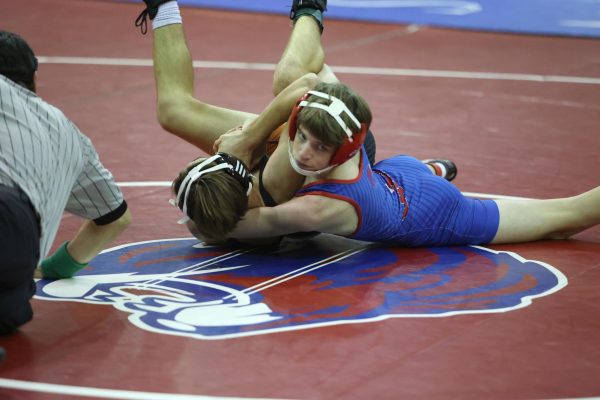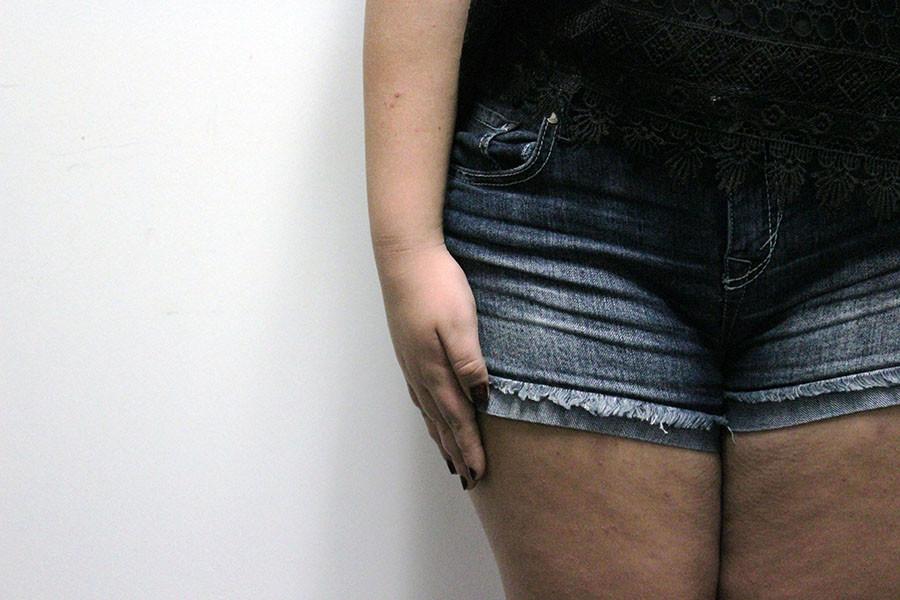Administrators sweep the school for dress code violations
Students sent to little theater during first period to be corrected
Students who are suspected of breaking dress code undergo the fingertip test. If the students fingertips pass their shorts, they are out of dress code.
This year, the administration has stepped up their enforcement of dress code violations with unannounced “dress code sweeps” during the first period of the day. An announcement comes on, teachers ask students to stand up so they can assess their clothing, and those in violation are sent to a designated area to be corrected or receive consequences. Dress code sweeps do not have a good effect because students will miss instructional time and some teachers don’t enforce the dress code, even during the sweep.
Roughly 25-30% of the student body comes to school out of dress code on any given day, if the rules are being followed to the letter. If all of those students were sent to one location with five administrators to assess them, it would take nearly 20 minutes to get to all of them, some of which can be addressed in 5 minutes while others have to wait much longer depending on their situation.
Two years ago, they tried tardy sweeps to curtail the number of tardies to 1st/5th period, but this method of lining up to wait for a pass kept students out of class even longer than the actual tardy. This can also happen to students in dress code sweeps. The student has to leave class, go to designated area, be assessed, change/have someone bring them clothes and then finally return to class (or be sent to ISS if they cannot change). This wastes a lot of instructional time.
The only ways a student who is dress coded can fix what they’re wearing is if they happen to have a change of clothes, the school gives them clothes or someone drives to the school and brings them clothes. Very few people walk around with extra clothes in their bags, and a lot of people’s parents or friends work during the day. When dress coding is happening on such a large of a scale, that becomes an issue, especially if students are receiving ISS because no one can bring them clothes and other students don’t receive the same consequences because they happened to have a change of clothes.
Not all teachers agree with the dress code or choose to enforce it. After the first sweep, several students said their teachers disregarded the announcement or hardly checked their class to see who was in violation of dress code. A student in one class might be sent to ISS because her Nike shorts are too short, but her friend in another class won’t have any consequences because her teacher did not address it with her. This creates anger among the students because the rules aren’t being followed across the board.
The two significant issues with the sweeps are the loss of instructional time and some teachers not choosing to enforce it. To reduce the amount of time spent out of class, teachers could assess their class during 1st/5th period and record each student’s name in an email or form that is sent to administration. Then during a non-instructional time like Pride Time or lunch, the student can be punished/corrected due to their violation. With teachers, if a student is found out of dress code later in the day on a day when a sweep occurred, their first period teacher should be reprimanded for not complying with the dress code sweep.
The dress code is a district policy, the school is required to enforce it. The method in which they have chosen doesn’t work properly. It can be fixed and administered more in a way that wouldn’t require students to miss as much class time.

My name is Austin Graham and this is my third year to be on the staff of The Roar and my second year as the Assistant Editor. I love dogs more than anything...





